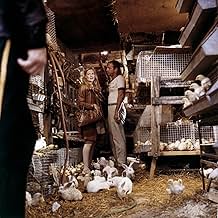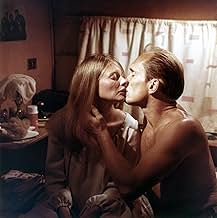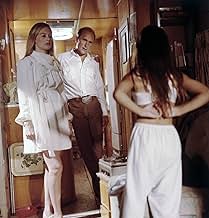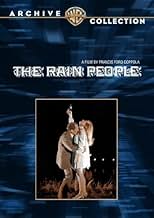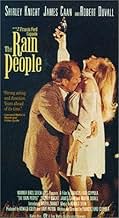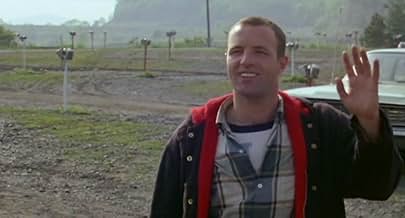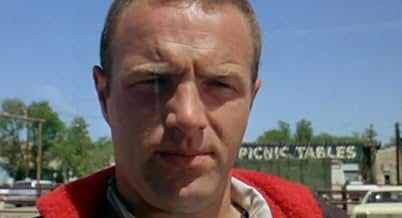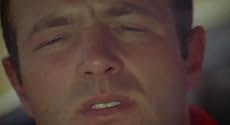IMDb RATING
6.8/10
4.4K
YOUR RATING
When a housewife finds out she is pregnant, she runs out of town looking for freedom to reevaluate her life decisions.When a housewife finds out she is pregnant, she runs out of town looking for freedom to reevaluate her life decisions.When a housewife finds out she is pregnant, she runs out of town looking for freedom to reevaluate her life decisions.
- Awards
- 1 win total
Laura Crews
- Ellen
- (as Laurie Crews)
Garrett Cassell
- Farmer
- (uncredited)
Eleanor Coppola
- Gordon's Wife
- (uncredited)
- Director
- Writer
- All cast & crew
- Production, box office & more at IMDbPro
Featured reviews
Early Coppola with sublime cast that most folks never got to see (a pity). There's some wonderful things going on in this one - Shirley Knight's best performance (an underrated actress), a road trip in the late 1960's, James Caan very restrained and moving, Robert Duvall in a part he was born to play (edgy, lonely, motorcycle cop), and a touching script with F. Coppola behind the wheel.
If this had been made five years LATER by some nobody, it would have been a smash (so much for timing). Anyway, I recommend this to all people who don't need outer-space explosions and bad mother-in-law jokes or a billion dollar budget to sit for a few hours and watch a story unfold. Give this one a chance if you can find it!
If this had been made five years LATER by some nobody, it would have been a smash (so much for timing). Anyway, I recommend this to all people who don't need outer-space explosions and bad mother-in-law jokes or a billion dollar budget to sit for a few hours and watch a story unfold. Give this one a chance if you can find it!
A 30-ish wife on Long Island (Shirley Knight) needs to just get away and so enters her station wagon and drives west. To where? She doesn't know, but she picks up an ex-college football player (James Caan) before meeting a motorcycle cop (Robert Duvall).
"The Rain People" (1969) was made three years before Francis Ford Coppola became famous with "The Godfather." It was his first movie in which he had total creative control, writing and directing on the road without producers breathing down his neck. The story was inspired by Francis' mother curiously leaving home for a few days when he was a kid. It's about a woman's haphazard search for freedom from the manacles of domestic life. Unlike the domineering male protagonists of "Patton" (which he wrote), the Corleone patriarchs and Kurtz in "Apocalypse Now," Coppola shows us here several females manipulating men: Natalie with Kilgannon, Gordon and even Vinny; Ellen with Kilgannon and her father; and Rosalie with her dad.
Interestingly, it's the express opposite of Francis' previous movie, the fun "Finian's Rainbow," which was based on the 1947 Broadway hit. One is an energetic musical with a large cast while this has an everyday, depressing tone, made with a small cast & crew. While neither were successful at the box office, they both went on to garner cult followings after Coppola's great success in the 1970s-90s (of course he had a few movies that didn't do so well, but what else is new?).
I can see where many viewers would find "The Rain People" dull, but it features a daring premise and has historical significance, not to mention some notable cast members. Plus, it's a quality period piece for the late '60s. In regards to the commendable premise, Natalie loves her husband, but is uncertain about the responsibility of having his child and so instinctively flees the scene. Ironically, Killgannon becomes her surrogate 'child' on her road odyssey wherein she struggles with her obligations.
Concerning the 'historical significance,' the industry proudly cites "Stand Up and Be Counted" as the first flick to address women's liberation, which it overtly does. But this came out three years prior and few people noticed at the time because it's so covert. It was ahead of its time.
Francis originally intended to include a scene at the end to clear up what Natalie decides to do from there, but it wasn't needed because everything is explained in her monologue. Listen.
It runs 1 hour, 41 minutes, and was shot over the course of five months in several American states with a 10-person crew (along with a smattering of locals). The locations include: Garden City (opening shot), Manhattan (Lincoln Tunnel) & Hofstra University, New York; the Pennsylvania Interstate; Harrisonburg, Virginia (restaurant scene); Clarksburg (the drive-in theater) & Weston, West Virginia; Chattanooga, Tennessee (the parade); Brule (the burning house) & Ogallala (the reptile ranch), Nebraska; and other places for exterior shots.
GRADE: B/B-
"The Rain People" (1969) was made three years before Francis Ford Coppola became famous with "The Godfather." It was his first movie in which he had total creative control, writing and directing on the road without producers breathing down his neck. The story was inspired by Francis' mother curiously leaving home for a few days when he was a kid. It's about a woman's haphazard search for freedom from the manacles of domestic life. Unlike the domineering male protagonists of "Patton" (which he wrote), the Corleone patriarchs and Kurtz in "Apocalypse Now," Coppola shows us here several females manipulating men: Natalie with Kilgannon, Gordon and even Vinny; Ellen with Kilgannon and her father; and Rosalie with her dad.
Interestingly, it's the express opposite of Francis' previous movie, the fun "Finian's Rainbow," which was based on the 1947 Broadway hit. One is an energetic musical with a large cast while this has an everyday, depressing tone, made with a small cast & crew. While neither were successful at the box office, they both went on to garner cult followings after Coppola's great success in the 1970s-90s (of course he had a few movies that didn't do so well, but what else is new?).
I can see where many viewers would find "The Rain People" dull, but it features a daring premise and has historical significance, not to mention some notable cast members. Plus, it's a quality period piece for the late '60s. In regards to the commendable premise, Natalie loves her husband, but is uncertain about the responsibility of having his child and so instinctively flees the scene. Ironically, Killgannon becomes her surrogate 'child' on her road odyssey wherein she struggles with her obligations.
Concerning the 'historical significance,' the industry proudly cites "Stand Up and Be Counted" as the first flick to address women's liberation, which it overtly does. But this came out three years prior and few people noticed at the time because it's so covert. It was ahead of its time.
Francis originally intended to include a scene at the end to clear up what Natalie decides to do from there, but it wasn't needed because everything is explained in her monologue. Listen.
It runs 1 hour, 41 minutes, and was shot over the course of five months in several American states with a 10-person crew (along with a smattering of locals). The locations include: Garden City (opening shot), Manhattan (Lincoln Tunnel) & Hofstra University, New York; the Pennsylvania Interstate; Harrisonburg, Virginia (restaurant scene); Clarksburg (the drive-in theater) & Weston, West Virginia; Chattanooga, Tennessee (the parade); Brule (the burning house) & Ogallala (the reptile ranch), Nebraska; and other places for exterior shots.
GRADE: B/B-
Francis Ford Coppola wrote and directed this stunningly personal story of a married woman's flight from her husband--and the reality that perhaps the youthful glee and excitement of her younger years are behind her. We learn little about this woman's marriage except that she has been feeling her independence slipping away as of late; she's also recently learned she's pregnant, which has further complicated her heart (she doesn't want to be a complacent wifey, despite the maternal way she speaks to her husband over the phone). She meets two men on her journey: a former college football hero who--after an accident during a game--has been left with permanent brain damage, and a sexy, strutting motorcycle cop who has a great deal of trouble in his own life. The clear, clean landscapes (as photographed by the very talented Wilmer Butler) are astutely realized, as are the characters. Shirley Knight, James Caan, and Robert Duvall each deliver strong, gripping performances, most especially since these are not very likable people in conventional terms. Some scenes (such as Knight's first call home from a pay-phone, or her first night alone with Caan where they play 'Simon Says') are almost too intimate to watch. Coppola toys with reality, turning the jagged memories of his characters into scrapbooks we've been made privy to. He allows scenes to play out, yet the editing is quite nimble and the film is never allowed to get too heavy (there are at least two or three very frisky moments). It's a heady endeavor--so much so that the picture was still being shown at festivals nearly five years later. Some may shun Coppola's unapologetic twisting of events in order to underline the finale with bitter irony, however the forcefulness and drive behind the picture nearly obliterate its shortcomings. *** from ****
Shirley Knight plays Sara Ravenna, a Long Island housewife who runs away from her marriage when she discovers she is pregnant. She plans to drive into America's heartland and start anew. Along the way she picks up a friendly hitchhiker (James Caan) who calls himself 'Killer.' Soon she discovers that the good natured 'Killer' is actually brain damaged, and by picking him up she has unknowingly taken on a huge responsibility. The two of them drive all the way to Nebraska, where Sara gets Killer a job helping out at a roadside reptile farm. It is here that Sara meets Gordon, a local cop, and soon things go horribly wrong for everyone.
This is a powerful drama about people disconnected from society, alienated by the choices they make or by the limits imposed on them by others. Even with such a low budget and a very freewheeling attitude, the film is able to capture everything that needs to be said through these clearly defined characters. Shirley Knight has a complex, diverging role and there are moments of some awe-inspiring acting by her. One of my favorites is when she is on the telephone calling her home to her worried husband the first time. It is such a tense scene on both ends, and in every small gesture and inflection of a word, so much about her is spoken with so little. Then comes in the character of 'Killer' played by James Caan. This character is unlike any I've ever seen him play, and he performs wonderfully. It's one of his best performances as he is very restrained and moving.
The way Coppola develops the characters by using short, dream-like flashbacks is very clever, adding a fragmented kind of view onto it all. The quick flashbacks that are graphic and self-contained contrast well with the longer shots in some crucial scenes. Also, because this film was shot on location all over the Eastern U.S., it offers an interesting, authentic look at America in the late 1960's.
I haven't seen many other films starring Ms. Knight, I'm only familiar with her more recent work on television, usually playing a nagging mother in law or a dotty old woman. It was great seeing her so young, beautiful, and so wonderfully subtle in this movie. It's also kind of a shame that James Caan went on to be typecast as the 'tough guy' for the rest of his career, because this film evidenced that he is capable of so much more than that.
This is a powerful drama about people disconnected from society, alienated by the choices they make or by the limits imposed on them by others. Even with such a low budget and a very freewheeling attitude, the film is able to capture everything that needs to be said through these clearly defined characters. Shirley Knight has a complex, diverging role and there are moments of some awe-inspiring acting by her. One of my favorites is when she is on the telephone calling her home to her worried husband the first time. It is such a tense scene on both ends, and in every small gesture and inflection of a word, so much about her is spoken with so little. Then comes in the character of 'Killer' played by James Caan. This character is unlike any I've ever seen him play, and he performs wonderfully. It's one of his best performances as he is very restrained and moving.
The way Coppola develops the characters by using short, dream-like flashbacks is very clever, adding a fragmented kind of view onto it all. The quick flashbacks that are graphic and self-contained contrast well with the longer shots in some crucial scenes. Also, because this film was shot on location all over the Eastern U.S., it offers an interesting, authentic look at America in the late 1960's.
I haven't seen many other films starring Ms. Knight, I'm only familiar with her more recent work on television, usually playing a nagging mother in law or a dotty old woman. It was great seeing her so young, beautiful, and so wonderfully subtle in this movie. It's also kind of a shame that James Caan went on to be typecast as the 'tough guy' for the rest of his career, because this film evidenced that he is capable of so much more than that.
Francis Ford Coppola's first 'personal' film, completed and released in 1969, was the last movie he made as a mostly unknown, up and coming director before The Godfather, and is in stark contrast to both that film, and the rest of his uneven career. It's ostensibly a road movie involving a disconnected young woman bored with domestic life, and pregnant with a child she isn't sure she wants, fleeing the trappings her dull marriage and hitting the open road in search of freedom. Along the way she befriends a nice man, an ex-footballer player that suffered brain damage from a traumatic head injury, played in unexpectedly subtle fashion by a young James Caan, and decides to 'help' him, despite becoming frustrated with his simple ways. Her efforts to rid of him always fail, either by guilt or chance, and eventually lead her directly into the hands of an emotionally wounded cop(Robert Duvall), who has ideas of his own. The plot is threadbare, but Coppola does a great job at detailing the emotional life of these characters, and uses editing techniques to relay back story that were not at all common in American films of the time. Shots are simple, yet extraordinarily effective, conveying both the moody desolation of the open highway, and the emptiness of American suburban life, infused with a gentle melancholy provided by the film score. Coppola also deserves credit for addressing the issue of domestic discontent from a woman's point of view in the culturally turbulent 60's. Overall, a fairly low-key film that is not what audiences have come to expect from Coppola, but one that is a minor triumph in its own quiet, unassuming way. 7.5/10.
Did you know
- TriviaThe parade scene was filmed in Chattanooga, Tennessee on Memorial Day. The students in the band were not aware of what was happening. In fact, reading the lips of a majorette, she can be seen asking, "Who was that guy?" as James Caan was weaving through the parade.
- GoofsWhen Natalie first leaves her husband, she drives into a tunnel and emerges from on the west side of Manhattan. That is, she has driven east through the Lincoln Tunnel, presumably heading east. But immediately after, she stops at a phone booth to call her husband, saying she is in Pennsylvania, which is in the opposite direction. Had the intention to suggest a westward journey, she could have driven west through the tunnel to emerge in New Jersey.
- Quotes
Natalie Ravenna: You are the most obedient man I've ever met in my life. Look at me. Aren't you?
Jimmy Kilgannon: Yes.
Natalie Ravenna: Aren't you?
Jimmy Kilgannon: Yes.
Natalie Ravenna: Aren't you?
Jimmy Kilgannon: Yes.
Natalie Ravenna: Aren't you?
Jimmy Kilgannon: Yes.
Natalie Ravenna: Alright.
- ConnectionsEdited into Filmmaker (1968)
- How long is The Rain People?Powered by Alexa
Details
- Release date
- Country of origin
- Language
- Also known as
- Dos almas en pugna
- Filming locations
- Chattanooga, Tennessee, USA(Veterans Day parade)
- Production companies
- See more company credits at IMDbPro
Box office
- Budget
- $750,000 (estimated)
Contribute to this page
Suggest an edit or add missing content



